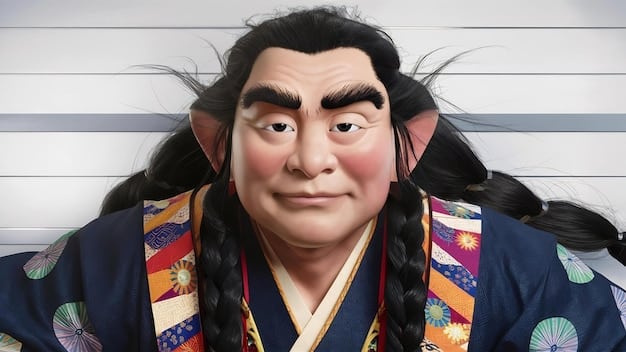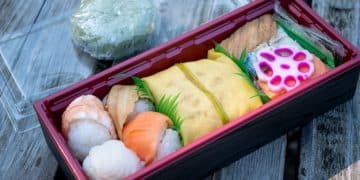Japanese Drama Dialogue: Master Basic Phrases for Enhanced Viewing

Mastering basic Japanese drama dialogue enriches your viewing experience by fostering a deeper connection with characters and storylines, offering both entertainment and practical language acquisition.
Delving into the world of Japanese dramas (J-dramas) offers a rich tapestry of storytelling, culture, and emotion. To truly immerse yourself, understanding some fundamental Japanese Drama Dialogue: Learning Basic Phrases to Enhance Your Viewing Experience can transform passive watching into an engaging linguistic adventure. Beyond mere entertainment, grasping common expressions allows for a deeper appreciation of character nuances and plot subtleties.
Understanding the Cultural Context of Japanese Dialogue
Japanese dramas are more than just entertainment; they are a window into the country’s intricate social customs, etiquette, and emotional expressions. The way characters speak—their choice of words, politeness levels, and non-verbal cues—is deeply embedded in Japanese culture. Understanding this context is crucial, as direct translations often miss the underlying meaning or social nuances.
For instance, the use of honorifics (e.g., -san, -kun, -chan) is rampant and speaks volumes about relationships and social hierarchy. A character calling another “sensei” (teacher/master) conveys respect for their knowledge or position, while an older sibling referring to a younger one with “chan” or “kun” denotes affection and familiarity. These subtle linguistic markers define friendships, romantic interests, family bonds, and professional connections within the narrative, making the dialogue far richer than a literal transcription.
Politeness Levels and Social Interaction
Japanese language operates on a complex system of politeness levels, known as “keigo.” While casual conversation (informal speech) is common among friends and family, formal or honorific speech is used when addressing elders, superiors, or strangers. J-dramas often showcase this dynamic, with characters shifting their speech patterns depending on who they are talking to. Observing these shifts helps viewers grasp the changing relationship dynamics and social interactions depicted.
- Casual (Tamego): Used among close friends, family, or those of lower status. It’s direct and often includes shortened forms or specific slang.
- Polite (Desu/Masu Form): The standard polite form, suitable for most everyday interactions and general conversation. It conveys respect without being overly formal.
- Honorific (Sonkeigo) & Humble (Kenjougo): Highly formal speech used to show extreme respect to others (honorific) or humble oneself (humble). Often seen in business settings or addressing highly esteemed individuals.
The mastery of these politeness levels by actors is a testament to Japanese linguistic artistry. Even without fully understanding every word, recognizing the tone and forms of address can greatly enhance your appreciation of character development and the drama’s underlying social commentary.
Essential Greetings and Everyday Phrases
Starting with the basics can significantly boost your confidence and comprehension. Japanese dramas frequently feature common greetings and everyday expressions that are repeated across various scenarios. Paying close attention to these can provide a foundation for understanding broader dialogue.
The most ubiquitous greeting, “Ohayou gozaimasu” (Good morning) or its informal variant “Ohayou,” sets the scene for many dramas, especially those set in schools or workplaces. Similarly, “Konnichiwa” (Good afternoon) and “Konbanwa” (Good evening) are heard constantly as characters interact throughout their day. These aren’t just polite formalities; they often establish the mood and relationship between speakers, hinting at their closeness or distance.
Commonly Heard Expressions and Their Contexts
Beyond simple greetings, certain phrases act as narrative anchors, frequently appearing in pivotal moments or common scenes. For instance, “Sumimasen” can mean “excuse me,” “I’m sorry,” or “thank you” depending on context, making it a versatile and essential phrase to recognize. If a character bumps into another, “Sumimasen!” expresses apology. If they ask for help, it’s an “excuse me.” If someone does them a small favor, it can be a subtle “thank you.”
- “Arigatou gozaimasu” / “Arigatou” (Thank you): Expresses gratitude; the longer form is more polite. Notice when characters use the informal version, indicating a closer bond.
- “Gomen nasai” / “Gomen” (I’m sorry): Essential for apologies. The informal “Gomen” is often used among friends, signalling quick forgiveness or playful remorse.
- “Itadakimasu” (Let’s eat / I humbly receive): Spoken before meals, it’s a cultural staple showing gratitude for the food.
- “Otsukaresama desu” (Good work / You must be tired): A nuanced phrase often heard in professional or school settings, acknowledging someone’s hard work or effort. It builds camaraderie.
Recognizing these phrases can help you follow the plot even when the Japanese is fast-paced. They often signal shifts in scene, character intentions, or social obligations, adding a layer of authenticity to the viewing experience.
Expressing Emotions and Reactions
J-dramas are renowned for their portrayal of deep emotions, from heartbreaking tragedies to lighthearted romances. Learning how characters express these feelings through dialogue is key to connecting with their journey. Japanese often uses interjections, exclamations, and specific phrases to convey a wide spectrum of feelings, sometimes more subtly than in Western narratives.
A simple “Hontou ni!?” (Really!?) or “Uso!?” (No way! / You’re kidding!?) can instantly convey surprise or disbelief. These short bursts of dialogue, often accompanied by strong facial expressions, are powerful indicators of a character’s internal state. Similarly, a drawn-out “Nani!?” (What!?) can signify shock or confusion, while a quiet “Daijoubu?” (Are you okay?) expresses worry or concern.
Nuances of Affection and Anger
Love, frustration, anger, and sadness are universal, but their expression in Japanese dialogue often holds unique cultural weight. Romantic confessions, for example, might be more understated, like “Suki desu” (I like you) or “Aishiteru” (I love you), which is often reserved for very deep declarations. Observe how characters use tone and context to convey intensity, rather than just the words themselves.
- “Kimochi warui” (I feel sick / disgusting): Can refer to physical sickness but often conveys a strong sense of disgust or unease about a situation or person.
- “Urusaai!” (Shut up! / Noisy!): A common exclamation of frustration or annoyance, often shouted dramatically in comedic or tense scenes.
- “Shinpai shinaide” (Don’t worry): A comforting phrase, often said by one character to reassure another during stressful times.
- “Setsunai” (Painful / Heart-wrenching): A unique Japanese term that describes a bittersweet or poignant feeling, often associated with unrequited love or longing.
These emotional expressions are not just standalone phrases; they are interwoven with character development and plot progression. Recognizing them helps you empathize more deeply with the characters and understand the emotional stakes of the story.

Understanding Common Requests and Commands
In the dynamic world of J-dramas, characters frequently make requests or issue commands. Understanding these basic phrases is essential for following the flow of conversations and plot developments, especially in workplaces, schools, or family settings. These can range from polite requests to urgent demands, each carrying a different weight and implication.
A ubiquitous polite request is “Onegaishimasu” (Please), often used when asking for a favor or when placing an order. Its versatility means it can appear in almost any scene where one character is asking something of another. For instance, a student might say “Onegaishimasu” when asking for an extension, or a customer when ordering coffee. Conversely, a clear command like “Yame nasai!” (Stop it!) or “Hayaku!” (Hurry!) can immediately signal urgency or conflict in a scene.
Polite Inquiries and Direct Orders
The distinction between polite inquiries and direct orders is a cornerstone of Japanese communication, heavily reflected in drama dialogue. Polite forms often involve “kudasai” (please give/do for me) or “masen ka?” (would you like to/won’t you?). Direct commands, on the other hand, often use imperative verb forms or specific exclamations.
- “Kudasai” (Please / Give me): Often appended to verbs to make a polite request, e.g., “Mite kudasai” (Please look).
- “~te kudasai” (Please do ~): Versatile suffix for polite requests, such as “Tasuke te kudasai” (Please help me).
- “Chotto matte kudasai” (Please wait a moment): A frequently heard phrase in daily interactions, useful for understanding delays or pauses.
- “Shiranai!” (I don’t know!): A blunt, often exasperated response indicating lack of knowledge or unwillingness to cooperate.
Observing who issues commands and who makes requests, and the context in which they do so, often reveals character hierarchies and personality traits, enriching the narrative beyond simple plot progression.
Navigating Questions and Answers
Dialogue in any form involves questions and answers, and Japanese dramas are no exception. Recognizing common question words and patterns is a fundamental skill for understanding conversations. Japanese questions are often formed by adding “ka” to the end of a sentence or by raising the intonation, but specific question words are also crucial.
The simplest question, “Nani?” (What?), is heard constantly, often with varying tones to express surprise, confusion, or even anger. Similarly, “Dare?” (Who?) and “Doko?” (Where?) are fundamental building blocks for gathering information within the storyline. Pay attention to how characters respond—a simple “Hai” (Yes) or “Iie” (No) can convey much information, but often responses are more elaborate, revealing personality and plot details.
Key Question Formations
Understanding the structure of questions helps you anticipate the kind of information being sought. Japanese doesn’t always rely on word order like English; particles and context play a significant role. For instance, topical particles like “wa” clearly mark the subject of a question, while others might indicate the direct object.
- “Kore wa nan desu ka?” (What is this?): A basic inquiry used when identifying objects or concepts.
- “Dou shita no?” (What’s wrong? / What happened?): A common question used to inquire about someone’s well-being or a situation.
- “Ikura desu ka?” (How much is it?): Useful in scenes involving shopping or transactions.
- “Itsu desu ka?” (When is it?): Helps determine timelines and schedules within the drama.
The way characters answer—whether evasively, directly, or emotionally—can be a strong indicator of their true intentions or hidden plot points, making question-and-answer exchanges critical to a full viewing experience.
Cultural Slang and Informal Speech
While mastering polite Japanese is valuable, much of the authentic charm of J-dramas comes from their use of informal speech and regional slang. Characters often use expressions that reflect their age, social group, and even the specific setting of the drama. These informalities might not be found in textbooks but are prevalent in everyday conversation and add significant depth to character portrayal.
For example, instead of the polite “Moshi moshi” when answering the phone, a close friend might simply say “Ossu!” or “Yo!”. Similarly, young characters, especially in high school or slice-of-life dramas, often use shortened phrases or unique interjections. This informal language can sometimes be challenging for learners, but it is indispensable for truly understanding character relationships and the overall tone of a show.
Recognizing Regional Dialects and Youth Slang
Japan has numerous regional dialects (hougen), and some dramas incorporate them for authenticity or comedic effect. While it’s impractical to learn every dialect, recognizing a few key markers can enhance appreciation. For instance, the Kansai dialect, common in Osaka, has distinct sentence endings like “nen” or “hen” that differ from standard Tokyo Japanese. Youth slang also evolves rapidly, mirroring trends and pop culture references.
- “Majide!?” (Seriously!? / Are you for real!?): A very common informal expression of surprise or disbelief among young people.
- “Yabai!” (Awesome! / Terrible!): A highly versatile slang term that can express strong positive or negative reactions depending on context.
- “Uzaami” (Annoying / Gross): Informal, often used by younger characters to express strong disliking.
- “Sugoi!” (Amazing! / Great!): While not strictly slang, it’s a very common informal exclamation of praise or astonishment.
By tuning your ear to these informal expressions and regional nuances, you not only improve your comprehension but also gain a richer, more authentic insight into Japanese society as depicted on screen.

Practical Tips for Active Listening and Learning from J-dramas
Simply watching J-dramas is a great start, but to truly learn and enhance your viewing experience, active listening is key. This involves more than just reading subtitles; it means engaging with the dialogue in a conscious, analytical way. The goal is to move beyond passive consumption to genuine language acquisition and cultural understanding.
One powerful technique is to start by watching with Japanese audio and English subtitles. Once you feel comfortable, switch to Japanese subtitles (if available). This forces your brain to try and match the sounds to the written Japanese words, reinforcing recognition. Don’t be afraid to pause and rewatch short scenes, especially those with dialogue you find particularly interesting or challenging. Repetition is a powerful learning tool.
Leveraging Resources for Deeper Understanding
To further deepen your understanding, consider supplementing your viewing with external resources. Japanese dictionaries, online phrasebooks, and language learning apps can be invaluable. Many language learners keep a notebook handy to jot down new words or phrases they encounter while watching.
- Use Subtitles Smartly: Start with English, then transition to Japanese subtitles for active learning. Avoid over-reliance on English subs if language acquisition is a goal.
- Listen for Repetition: Common phrases and character catchphrases are great for reinforcing learning. Note how they are used across different situations.
- Contextual Clues: Pay attention to non-verbal cues, facial expressions, and scene settings. These often provide critical context for understanding dialogue even if you miss a few words.
- Character Speech Patterns: Observe how different characters speak—do they use polite language, informal slang, or a specific regional dialect? This helps with character analysis and understanding social dynamics.
By approaching J-dramas as a language learning opportunity, you’ll not only enjoy the stories more fully but also organically build your comprehension of spoken Japanese in a fun and engaging way. This active engagement transforms entertainment into education, making every viewing a step forward in your linguistic journey.
| Key Aspect | Brief Description |
|---|---|
| 🎭 Cultural Nuances | Dialogue reflects Japanese social customs, politeness (keigo), and relationships, essential for deep understanding. |
| 🗣️ Essential Phrases | Mastering greetings, apologies, and basic reactions significantly boosts comprehension. |
| 💬 Informal Speech | Recognizing slang and regional dialects adds authenticity and deepens character understanding. |
| 🎧 Active Listening | Engaging with subtitles and rewatching scenes transforms passive viewing into active learning. |
Frequently Asked Questions About Japanese Drama Dialogue
▼
Understanding basic Japanese dialogue enhances your J-drama viewing by allowing you to grasp subtle emotional cues, cultural nuances, and character relationships that might be lost in translation. It fosters a deeper connection with the story and characters, moving beyond mere plot summaries to a richer, more immersive experience. It also serves as an enjoyable way to learn practical Japanese phrases.
▼
You’ll frequently encounter “Ohayou gozaimasu” (Good morning), “Konnichiwa” (Good afternoon), and “Konbanwa” (Good evening). Beyond these, “Oyasumi nasai” (Good night) is also common. Recognizing these basic greetings is a great first step, as they often set the tone for conversations and indicate the time of day within the drama’s narrative, providing immediate context.
▼
Politeness levels (keigo) profoundly influence dialogue in Japanese dramas by reflecting social hierarchy, respect, and character relationships. Characters use different forms (casual, polite, honorific) depending on who they are speaking to, their age, and their social standing. Observing these shifts helps viewers understand power dynamics, intimacy levels, and underlying social rules, enriching the narrative significantly.
▼
While watching dramas is an excellent supplement to traditional learning methods, it’s generally not sufficient on its own for comprehensive fluency. Dramas expose you to natural spoken Japanese, intonation, slang, and cultural contexts, which are invaluable. However, combining drama viewing with structured language lessons, grammar studies, and active practice will yield the most effective and well-rounded learning experience.
▼
“Otsukaresama desu” is a versatile and common phrase in J-dramas, meaning “You must be tired” or “Good work.” It’s frequently used in workplaces, schools, and social settings to acknowledge someone’s effort, hard work, or contribution. It’s a way to show appreciation and build camaraderie, reflecting Japanese cultural values of collective effort and recognizing the burdens others carry, making it vital for social cohesion.
Conclusion
The journey into Japanese dramas is far more rewarding when you engage actively with their linguistic landscape. Understanding basic phrases and the cultural nuances embedded within Japanese dialogue not only elevates your viewing pleasure but also provides a dynamic and entertaining pathway to language acquisition. By paying attention to greetings, emotional expressions, commands, and even informal speech, you unlock deeper layers of meaning, connecting more intimately with the characters and the rich tapestry of Japanese storytelling. Embrace the dialogue, and let each J-drama become a step in your linguistic and cultural exploration.





